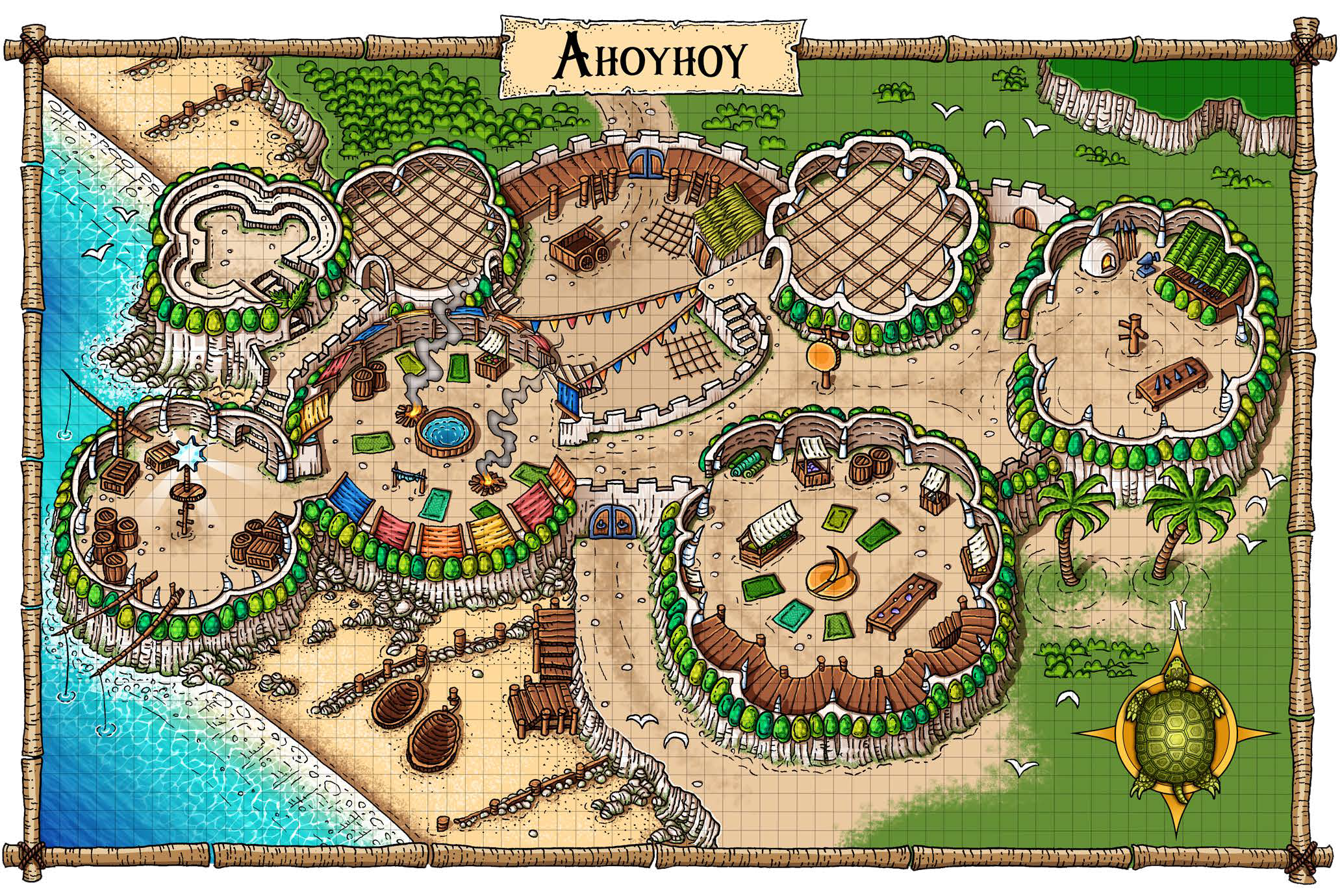Ahoyhoy
More a trade post or fort than a proper town, Ahoyhoy is the breeding ground and primary trade post of the Omgar Tortles. Here, tortles socialize, lay eggs, and do buisness with the other peoples of Procan's Depths. It is also the home of the Grand Shanty.
Demographics
There are typically about 5-25 adult tortles and 2-12 young tortles in Ahoyhoy, supplemented by the staff of the Grand Shanty, who are mostly humans and number to about 10.
Government
There is no government in Ahoyhoy, though the community leader is by default the eldest and wisest Tortle, typically Mudgraw. Guests and inhabitants alike are socially expected to be on their best behabior, and anyone who misbehaves is asked to leave - or dispersed by force if necessary.
History
Founded long ago, the fort of Ahoyhoy was largely obscure visited only by the tortles that called it home and the Jan Pana of the mainland for generations. Despite this, it was always a hub of trade and seen as neutral ground, never taking a side in regional conflicts. This status enriched the tortles, who benefited from the immense wealth and generosity of the Jan Pana - both materially and culturally. The trade of goods and stories continued with the arrival of the dwarven empires, but was forever changed by their presence.
As the empires expanded into Procan's depths, the Snout of Omgar developed into an important stopover port. In the 150s, a pirate ship captained by occultists was marooned in a storm. This brought the only period of occupation the tortles can recall, where the cult's leader impressed them into service and forced the creation of the Typhoon Palace. Despite this, the culsits died out and Ahoyhoy was once again made a safe place. Early imperial scouts and colonists traded manufactured goods and riches for food and supplies to continue their journies, causing a population and economic boom in Ahoyhoy that lasted a generation.
Unfortunately for the tortles, colonization of the Daybreak Peninsula led to the creation of imperial ports of greater size and wealth. These ports replaced Ahoyhoy as the main stopover during long voyages, and the town returned to it's status as a somewhat obscure trading outpost for the remaining Jan Pana and a few imperial traders. This shift brought an unfair reputation to Ahoyhoy as a port full of smugglers and undesirables.
During the Cobalt Reconquista, however, imperial ports were sacked and Ahoyhoy was once again catapulted into prominence as one of the few ports that was safe from the Sea Princes for imperial ships, and safe from the Empire for pirate vessels. Despite both navies having the means to sack the fort, neither had the desire to: it was more useful as an economic hub, and the island had no useful resources for colonization nor strategic importance that could not be matched and surpassed by ports on the mainland. At the eve of the conflict, the captured sea prince ship The Pig's Whistle was brought to anchor at Ahoyhoy and rechristened the Grand Shanty, which has yielded peacetime travel and tourism to the fort via not just imperial commerce, but also bar tourism by the rich and eccentric.
As the empires expanded into Procan's depths, the Snout of Omgar developed into an important stopover port. In the 150s, a pirate ship captained by occultists was marooned in a storm. This brought the only period of occupation the tortles can recall, where the cult's leader impressed them into service and forced the creation of the Typhoon Palace. Despite this, the culsits died out and Ahoyhoy was once again made a safe place. Early imperial scouts and colonists traded manufactured goods and riches for food and supplies to continue their journies, causing a population and economic boom in Ahoyhoy that lasted a generation.
Unfortunately for the tortles, colonization of the Daybreak Peninsula led to the creation of imperial ports of greater size and wealth. These ports replaced Ahoyhoy as the main stopover during long voyages, and the town returned to it's status as a somewhat obscure trading outpost for the remaining Jan Pana and a few imperial traders. This shift brought an unfair reputation to Ahoyhoy as a port full of smugglers and undesirables.
During the Cobalt Reconquista, however, imperial ports were sacked and Ahoyhoy was once again catapulted into prominence as one of the few ports that was safe from the Sea Princes for imperial ships, and safe from the Empire for pirate vessels. Despite both navies having the means to sack the fort, neither had the desire to: it was more useful as an economic hub, and the island had no useful resources for colonization nor strategic importance that could not be matched and surpassed by ports on the mainland. At the eve of the conflict, the captured sea prince ship The Pig's Whistle was brought to anchor at Ahoyhoy and rechristened the Grand Shanty, which has yielded peacetime travel and tourism to the fort via not just imperial commerce, but also bar tourism by the rich and eccentric.
Points of interest
South Gate
Stone walls capped with tortoise shells protects the fort to the south. Built into the wall and guarded by two tortles is a wooden double door, which typically is unlocked (though can be barred if necessary). The massive doorway is ten feet tall and twelve feet wide, with the walls towering fifteen feet high. Through the doors and a short tunnel leads to the courtyard detailed below.Also by the south gate are two fishing boats tethered to the piers west of the path leading up to the gate.
North Gate and Courtyard
Identical in construction to the south gate, the north gate is guarded by ten-foot high wooden ramparts on the inside of the wall that allows guards to watch over the entrance. Past the doors is the courtyard of Ahoyhoy, which is typically inhabitated by tortles repairing fishing nets and other equipment. A roofed stable to the east contains boars, mules, and a chicken coop with feed stored in a loft. The animals inhabiting this sandy courtyard were all imported by the tortles from foreign lands. Stone stairs lead from the coutyard to other regions of the multitiered fort.Living Area
Covered by awnings and adorned with woven mats atop the sandy ground, tortles sleep, sit, socalize, and work in these quarters. Fish and meat are often hung to dry or cook over small fires here, while a central basin collects rainwater for drinking. The living quarters are always colorful, both with textiles and people. When more water is required for larger populations, cermaics vases are taken to collect water from one of the small streams elsewhere on the isle.Fishing Space and Storage
In this coastal baily sit several crates and barrels full of nets, bait, hooks, line, and other supplies. Many long wooden rods are set from the walls, which the tortles use to catch fish from the shallows. Most curiously, a star of polished steel (yet another import) fixed to a tall wooden post climbs out of this region. It is used to warn fishing boats to the west of when the fort is under attack by reflecting starlight and moonlight.When the tortles have a surplus of goods (both from the island and collected from their travels) they are waiting to export, those goods are stored here. During particularly wealthy seasons, these goods can pile high.
Amphitheater
The tallest building in Ahoyhoy, the amphitheater's pallisade is the most decorated of all. Here tortles gather not only to conduct community buisness and socialize, but also tell stories. Storytime is a spectacular occassion, and tortle storytellers are typically accomplished travelers, wise sages, and skilled entertainers. Among the crowd - and even sometimes in the center telling the tale - are often visitors and non-tortle, be they from the Grand Shanty or foreign traders stopping in the small port fort.Egg Hatcheries
A pair of large and sandy areas are reserved for the hatching of new tortles. Rope nets are stretched from wall to wall, protecting the eggs from flying predators or other attack. The hatcheries are almost always inhabited by at least a few elderly tortles, who are either watching over the five-pound eggs growing in the hatchery or teaching the newborn tortles stories and how to walk on two legs. Once the newborn can walk and has been educated, they are free to join the community as a young tortle.Gong
The giant gong was forged from beaten bronze and has since been wrapped in a myriad of lizard hides stiched together. Sitting in the middle of the fort, it is attended to by simply a mallet. Any tortle may ring the gong (there is no specific gong attendee) but it must only be used for one of the four signals:- A single beat denotes visitors have come by land.
- A pair of beats indicates travelers by sea.
- A trio of beats is a call to gathering in the amphitheater.
- Finally, four beats on the gong warns of an imminent assault on Ahoyhoy.
Smithy
The eastern portions of the fort hold a stone forge and other euipment for metalworking, carving, and hide tanning. These facilities are made to create tools, shields, and weapons and even contain a wooden dummy for weapon testing.Market
The tortle market is covered in woven mats to keep out the sand and contains many wooden stalls adorned with display tables. Standing in the center is a stone sundial, with stairs leading up to the southern wall's ramparts.The southern gate's guards can also see into the market, which not only sells products made from the flora and fauna of the isle but also items from visitors that the tortles no longer have need for, which can include weapons and armor. Tortles, however, do not trade in armor. Trade may be conducted via bartering or with coin, now that increased contact with the outside world has yielded greater opprotunity to spend the world's many currencies.
The Grand Shanty
For details on the Grand Shanty, please see it's page here.Tourism
Ahoyhoy is visted by many travelers throughout the year, seeking to learn from tortles, conduct business with them, search the surrounding isle for treasure, or rest at the local inn, the Grand Shanty. In the 200s IA, these visitors tend to be from all over the Empire of Keoland, but can also be Jan Pana or even from the Empire of the Silver Crown. Even then, with the massive span of these empires such visitors can vary greatly in species, area of origin, and life experince. The tortles are always curious to see what goods they have, and happy to hear of their tales.
Architecture
The fort of Ahoyhoy is built of stone walls and decorated with shells - both of tortoises and marine creatures. Rooms tend to be open to the sky and round in construction, with a few crenelated walls protecting gates and other strategic locations. Awnings and mats are woven of local reed and imported textiles, and as such vary greatly in texture and color.
Natural Resources
The most expoiltable natural resource of Ahoyhoy is, by far, the abundant fish that swim in nearby waters. Tortles use shore-mounted fishing rods to catch those in the shallows, while small rowboat-like vessels take tortles out to deeper waters, where nets and rods are used to catch other fish.
Founding Date
Before written memory
Type
Trade post
Population
As low as 10 in the winter and as high as 60 in the summer
Location under




Comments